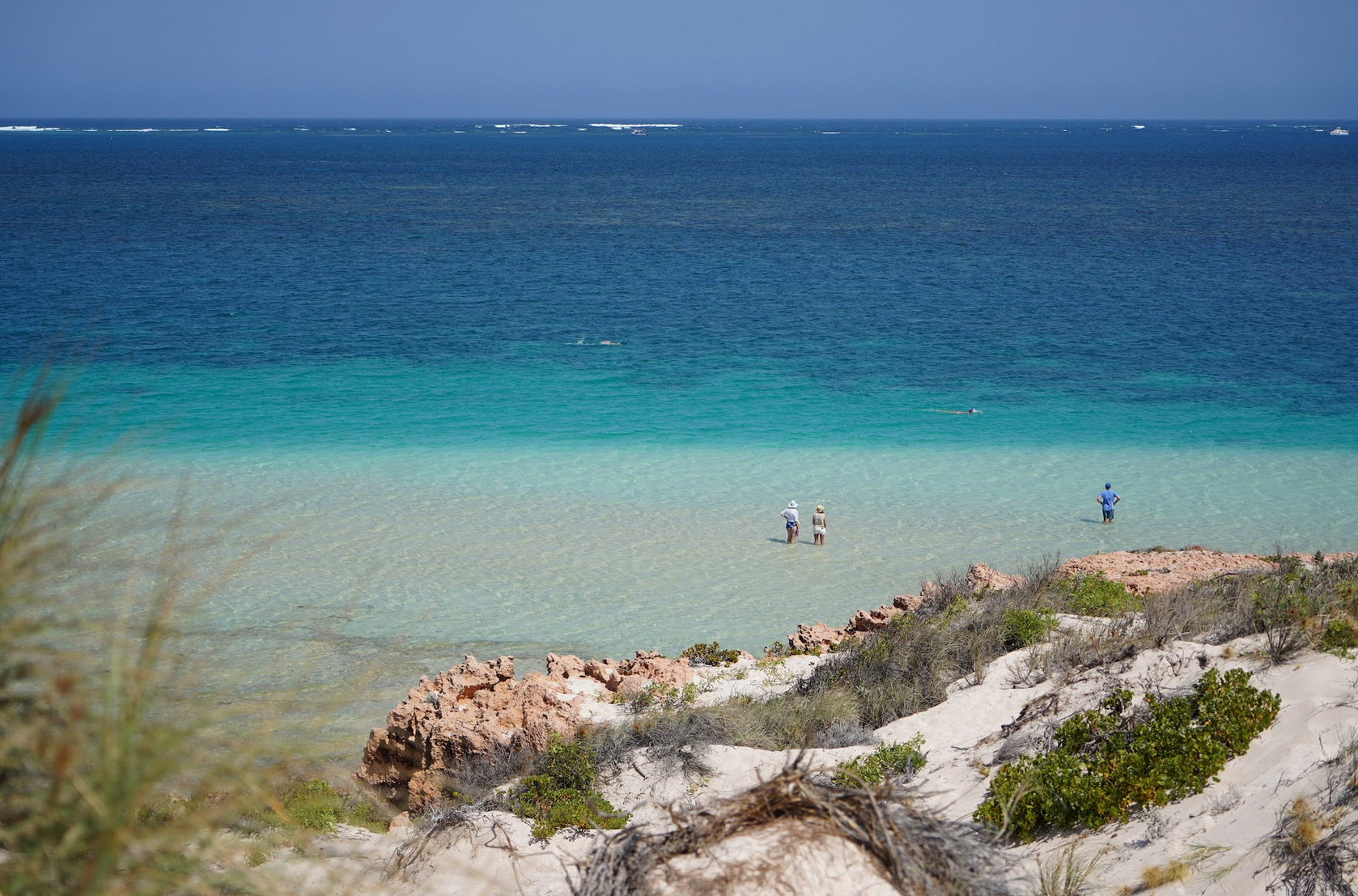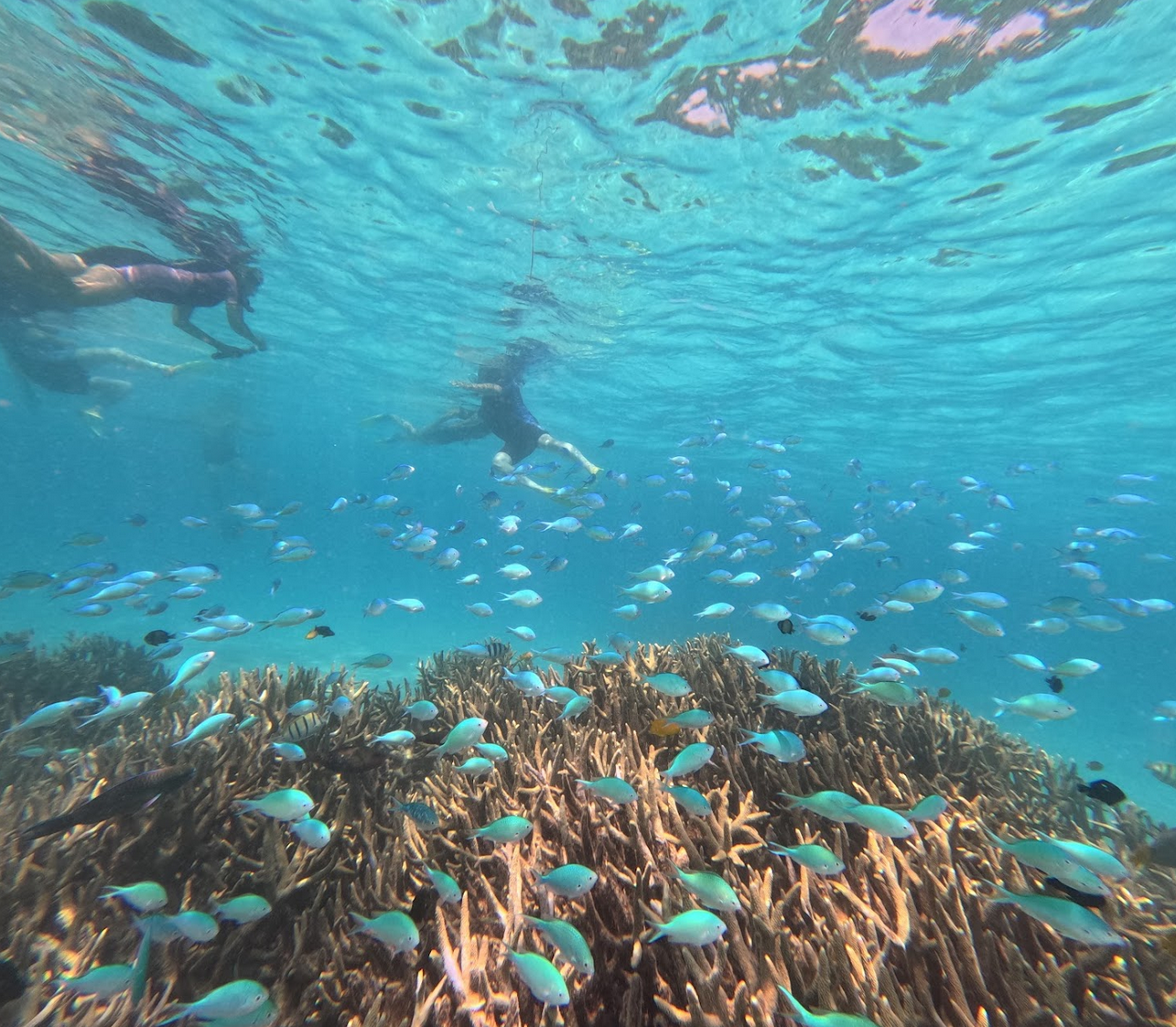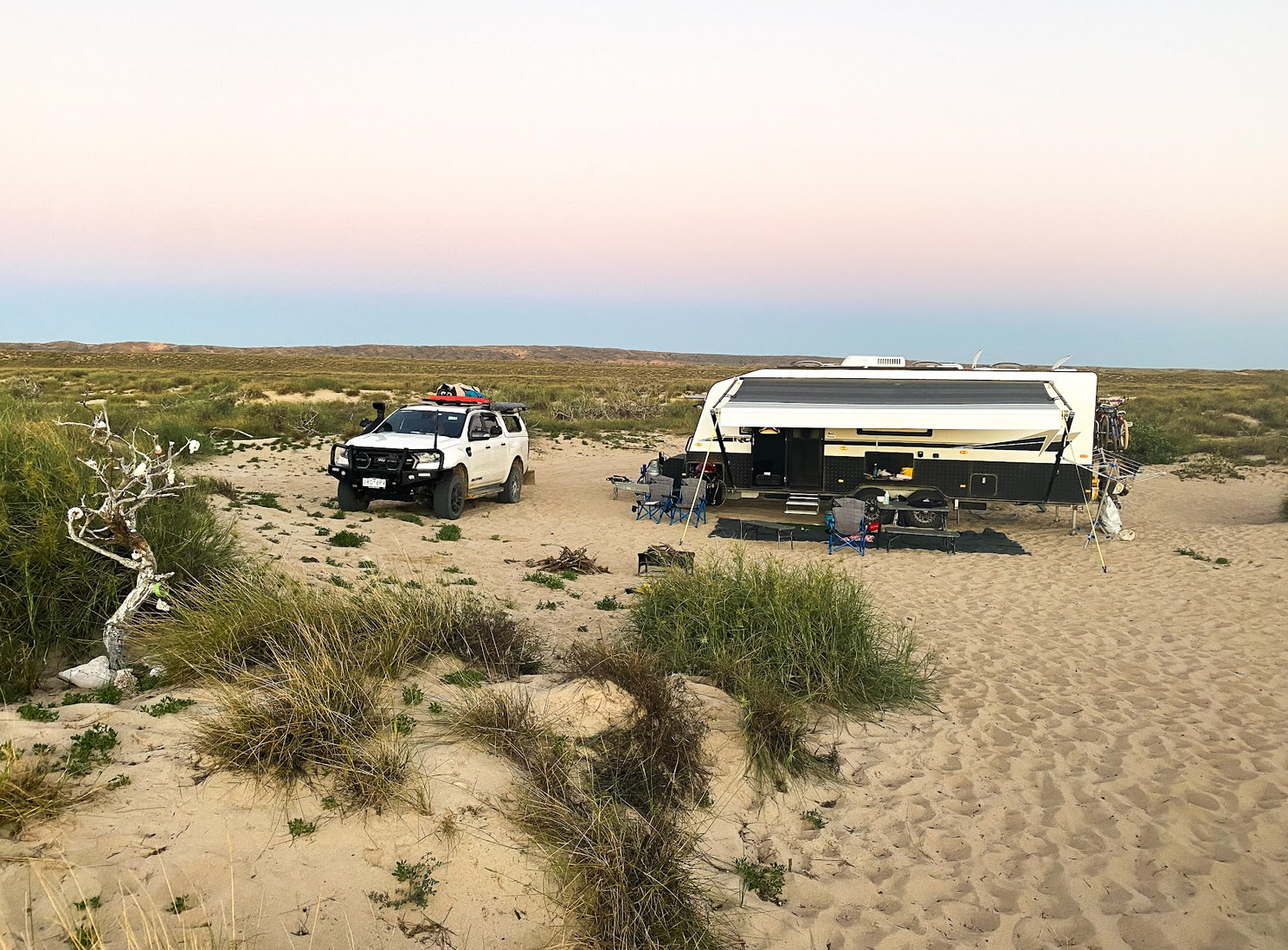Imagine unhitching your caravan on the beach overlooking the world’s largest fringing coral reef. Turtles greet the dawn, afternoons are spent barefoot – swimming, fishing and snoozing – and the days end with riotous overwater sunsets and campfires beneath a canopy of stars. World Heritage listed Ningaloo/Nyinggulu is one of Australia’s great road trip destinations. A place of hyper-saturated contrasts, where desert meets the reef and ancient limestone ranges give way to shimmering white-sand beaches. If you have a 4WD and a self-contained RV, there are some epic beach camps to enjoy. Here is your ultimate Ningaloo road-trip itinerary.
Coral Bay is the southern gateway to the Ningaloo Coast, a sleepy coastal village tucked behind a curve of pearlescent white sand. It’s an 1,100-kilometre drive from Perth, but worth the journey once you clap eyes on the water. The town beach is Bill’s Bay, a wide swathe of sand lapped by calm turquoise water and hemmed at the southern end by a limestone bluff. Grab your mask and snorkel (or hire a set from the beach shack) because the reef begins about 10 seconds after your feet get wet. In another 10 seconds you’ll come face to face with a turtle, then reef sharks and scores of colourful fish playing peekaboo. Coral Bay sure lives up to its name.
Walk up the bluff for views overlooking the reef and to the Indian Ocean beyond. Hire a paddle board or kayak, or let someone else do the work on a glass-bottom boat tour. For the ultimate Coral Bay underwater experience, join a manta ray cruise to swim with one of Ningaloo’s great marine megafauna. Coral Bay is home to the second-largest population of mantas on Earth, after the Maldives, thanks to a plentiful supply of nutrients flushing through the lagoon. Spotter planes find them from the air – then snorkellers quietly slip into the water, swimming alongside the mantas as they glide through the water like giant underwater birds.

Coral Bay from the Bluff. Credit Catherine Best
Camp at Peoples Park, located opposite the bay and within walking distance to everything in town. There’s no water hook-up, so come with full tanks.
The drive from Coral Bay to South Lefroy Bay Campground, in Nyinggulara National Park (formerly Ningaloo Station), will take at least two hours. The road is unsealed and corrugated, with areas of heavy sand. It is unsuitable for 2WDs and touring caravans. If you don’t have a 4WD and high-clearance caravan, press on to Cape Range National Park via the blacktop, rounding North West Cape after Exmouth. The journey to South Lefroy can be punishing but it’s utterly rewarding once you set up on the sand to enjoy uninterrupted views across the ocean. There are no facilities here except for a dump point and non-potable water tap, so bring everything with you and be prepared to live the castaway life for a few days.
Fishing, snorkelling, swimming and boating are the top pastimes here, and the setting is idyllic. If you’ve ever dreamed about falling asleep to the sound of lapping waves and launching into the water in a nanosecond – South Lefroy is for you. There are 4WD trails and remote beaches to explore, as well as the remains of the Norwegian Bay Whaling Station, 10 kilometres south of the campground.
South Lefroy Bay is one of five campgrounds in Nyinggulara National Park. Sites are hugely popular and bookings open 180 days in advance.
When it’s time to start making your way back to civilisation, take the Ningaloo-Yardie Creek Road north to Cape Range National Park. The track brings more of the same sand and corrugations and culminates in a water crossing at Yardie Creek. Hopefully the crossing will be dry but check conditions before you arrive, as vehicles have been horrendously bogged here. Kiss the bitumen on the other side of the creek, offload your rubbish in the bins and make your way to Osprey Bay – the most coveted campsite on this stretch of the Ningaloo Coast.
Use the campground as a base for exploring the beaches, limestone gorges and rust-red crags of Cape Range. The most popular walk is the two kilometres return Yardie Gorge Trail. This spectacular Class 4 hike skirts along Yardie Creek, before climbing high onto the sandstone cliffs. Keep your eyes peeled for wheeling ospreys and black-footed rock wallabies, precariously clinging to cliffside crevices with their seemingly adhesive feet. Walking can be heavy-going in the heat, and before long the beaches beckon. Turquoise Bay is Ningaloo’s most famous strand – twin ribbons of white sand deserving of their title. You can either turn left at the carpark and enjoy a drift snorkel (be mindful of the strong currents at the sandy point), or swim in the tranquil bay to the right of the point. Also popular with snorkellers are Oyster Stacks (accessible at high tide only; be careful of the rocky shore entry) and Lakeside. During turtle season (November to March) you can watch turtles nesting at the Jurabi Turtle Centre and Graveyards beach rookery.

Snorkelling Ningaloo Reef. Credit Catherine Best.
Osprey Bay Campground has excellent sites overlooking a first-rate snorkelling beach. There are drop toilets and sites are hotly contested, so get in early.
After beach camping for several nights, you will need to refuel, fill the water tanks and restock the cupboards. Take the bitumen road around the tip of North West Cape to Exmouth, where you will find a thriving Outback town with supermarkets, caravan parks and a top-notch brewery. Exmouth is the best place to bag that bucket-list Ningaloo experience – swimming with whale sharks (March to August), as tours all depart from town. Swimming alongside the biggest fish in the sea – moving like a giant underwater constellation – is a spine-tingling experience. If you’re a scuba diver, diving the Exmouth Navy Pier is also not to be missed.
Exmouth has had a strong military presence for more than 60 years. Once dubbed ‘little America’, the town was home to a US naval communications base from the 1960s until 1992 (the 13 communications towers remain in use today). You can learn about Exmouth’s cold war history, cyclones, and the region’s unique geology and marine habitat at the Ningaloo Aquarium and Discovery Centre. Drive up to Vlamingh Head Lighthouse where you can see the remains of an old WWII radar station and take in sweeping 360-degree views of the cape. This is one of the few places in Australia where the sun rises and sets over the ocean.
Don’t leave town before exploring the twin viewpoints at Shothole and Charles Knife canyons (the turnoffs are about 15 minutes’ drive south of Exmouth). Charles Knife is Western Australia’s answer to the Grand Canyon – a plunging valley ringed by precipitous cliffs and jagged ridges peppered with spinifex. There are various turnoff points along Charles Knife Road where you can park and enjoy the view on the way to Thomas Carter Lookout. The vistas are eye candy for your Instagram feed.
RAC Exmouth Cape Holiday Park is near the centre of Exmouth opposite the visitor centre and has spacious level sites, a large resort pool, games room, and a (paid) car and trailer wash bay.

South Lefroy Bay Campsite. Credit Catherine Best
Category: Destinations
Written: Mon 30 Sept 2024
Printed: October, 2024
Published By: